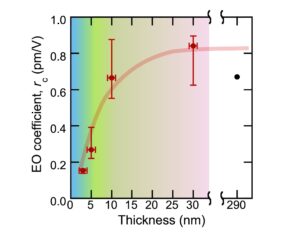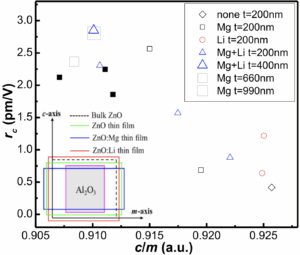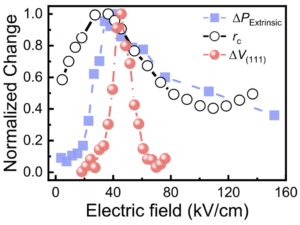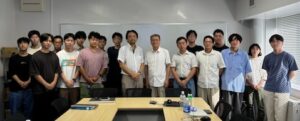Welcome to Yamada group
Published: Thickness Dependence of EO Properties in HZO Films: Evident Response down to 3 nm
Our paper entitled “Thickness Dependence of the Electro-optic Properties in Epitaxial Hf0.5Zr0.5O2 Thin Films: Evident Response Down to 3 nm” has been published in Appl. Phys. Lett. We found that although the effective EO coefficient, reff, remained almost unchanged down to 10 nm and decreased with a further decrease in thickness, the evident EO response was observed down to 3 nm, which agrees with the fact that HZO films can maintain ferroelectric properties down to a few monolayers in thickness. The small reff in the HZO films with thickness below 5 nm is attributed to the stabilization of the ferroelectric rhombohedral-like phase.

Published: Distinct roles of Mg and Li in affecting EO properties of ZnO thin films
Our paper entitled “Distinct Roles of Mg and Li in Affecting the Electro-optic Properties of Wurtzite ZnO Thin Films” has been published in Appl. Phys. Lett. Increasing the Mg content in ZnO significantly enhances internal parameter u and reduces the anion–cation bond lengths along the c-axis direction. This facilitates Zn displacement along the c-axis direction and increases electric susceptibility, enhancing the ionic contribution to rc. As opposite to Mg, Li incorporation produces slight lattice expansion and increases anion–cation bond lengths along the c-axis orientation. Larger rc could be reached by optimizing the Mg and Li content as well as the thickness. These findings suggest the great potential of widegap ZnMgO:Li thin films for applications to EO modulation in ultraviolet band.

Staff member
Dr. Shinya KONDO (assistant professor) and Dr. Kosuke ONO (research assistant professor) join us today.
Dr. Xueyou YUAN was promoted to a research lecturer. Congrats!
Awarded: Natsuki TAKAHASHI
Natsuki TAKAHASHI won the Dean’s award for School of Engineering.
Awarded: Natsuki TAKAHASHI
Natsuki TAKAHASHI won the Fellow Award of Atomic Energy Society of Japan for his research on optical memristors.
Published: Dynamic Domain Motion Enhancing Electro-optic Performance in Ferroelectric Films
Our paper entitled “Dynamic Domain Motion Enhancing Electro-optic Performance in Ferroelectric Films” has been published in Appl. Phys. Lett. We found that rhombohedral (111)/(11-1)-PZT film, consisting of domains with two distinct out-of-plane polarization components, exhibited an enhanced EO response upon the application of an AC field of approximately 40 kV/cm. This enhanced EO response was directly related to field-induced reversible domain switching, as confirmed by electrical measurements and time-resolved synchrotron XRD. These results indicate that the dynamic domain motion in ferroelectrics is an effective strategy for enhancing the EO response.

Alumni meeting
1st alumni meeting of Nagasaki-Yamada lab. was held on Nov. 23rd.
Awarded: Mizuki ISHIDA
Mizuki ISHIDA won the presentation award of The 44th Electronics Division Meeting of the Ceramic Society of Japan held in Keio University, Japan for his presentation on doped pyrochlore dielectric materials.

Seminar: Prof. Guorong Li, Dr. Lei Meng, Dr. Xueyou Yuan
On Jul. 18, Prof. Guorong Li (Shanghai Institute of Ceramics) visited us and lectured on high-entropy ferroelectric ceramics. In addition, Dr. Lei Meng and Dr. Xueyou Yuan gave their seminars.
1) Fabrication and Properties of ABO3 Ferroelectric Ceramics with A- and B-site disorder for high-energy storage (Prof. Guorong Li)
2) Strong Second-order Nonlinear-polarization in Widegap ZnMgO Thin-films with Li Incorporation (Dr. Lei Meng)
3) Extraordinarily Large Extrinsic Contribution Ratio to Piezo-response in Monoclinic (K, Na)NbO3 Epitaxial Films (Dr. Xueyou Yuan)

